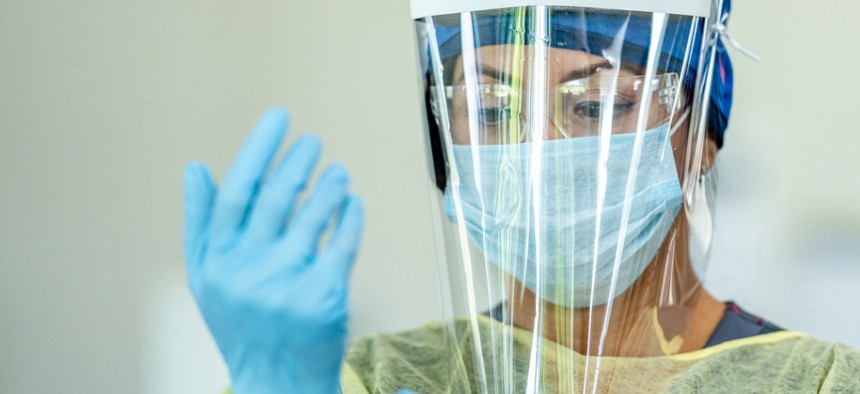Health Agency Seeks Feedback on Personal Protective Technology Hub

FatCamera/istockphoto.com
The National Institute for Occupational Safety and Health is looking for innovative ideas to maximize the protection different types of gear offers in different industry sectors.
The Centers for Disease Control and Prevention’s National Institute for Occupational Safety and Health, or NIOSH, released a request for information on the need to establish centers of excellence for research and practice needs in the area of personal protective technology, known as PPT.
Before the pandemic, it is likely that only the health care sector was familiar with the PPT acronym or what it represented. Today, after more than 18 months of N95 masks, face shields, surgical gloves, and other precautionary and protective devices, most of the American public knows of these measures even if they don’t know the acronym.
Because PPT can be used in many disciplines and industries, NIOSH is calling for “innovative thinking and approaches” to maximize PPT protective capabilities in different work environments. For instance, the House Select Subcommittee on the Coronavirus Crisis issued a report Oct. 27 regarding the pandemic’s effects on the meatpacking industry. Meatpacking plants, characterized by crowded work conditions and strenuous manual labor, suffered significantly higher coronavirus transmission rates than previously estimated. The kinds of personal protective equipment needed in those conditions clearly are different from those needed in retail or software development, for comparison.
The NIOSH request for comments identifies three broad areas that would be addressed by one or more future centers of excellence:
- Research and development of new PPT technologies and approaches, including sensor technology, to increase effectiveness.
- Human factors/ergonomics approaches to evaluating the factors that influence adoption and use of PPT, such as performance, comfort, fit and usability, and “sociotechnical systems analyses” of how factors such as health and safety management systems, safety culture and regulatory requirements influence PPT use.
- Innovative approaches to design, manufacture and the maintenance of PPT that can enhance factors such as the effectiveness and acceptance of PPT in different user populations, availability and whether they can be customized and produced rapidly during crises.
In addition, NIOSH has posed eight questions for which it is seeking input:
- What are the perceived needs for and benefits of establishing centers of excellence for PPT research and practice as it relates to your organization or for you personally?
- Are there specific PPT research and practice needs for certain industry sectors and/or occupations?
- Are there specific PPT research and practice needs for different types of hazards (e.g., biological, chemical, gas and vapor, thermal, physical)?
- Are there specific PPT research and practice needs for certain anatomical categories of protection (e.g., skin, vision, hearing, respiratory)?
- Which particular academic disciplines, research domains or technical expertise should contribute to addressing PPT research and practice needs? Describe multi- or inter-disciplinary needs to most effectively advance research and practice.
- Describe merging or novel technologies that can be investigated with respect to increasing PPT effectiveness.
- How well do the three broad focus areas identify critical needs? Are there alternate or additional needs that have not been identified in this request?
- NIOSH anticipates that future PPT centers of excellence will include at least three functional core areas: planning and evaluation, including administration; research, which may include pilot projects, small projects and large projects; and outreach, which can include communication and dissemination activities, education activities and implementation activities. How important are each of these areas with the overall function of the new centers for excellence?
This request is scheduled for the Federal Register Nov. 2, 2021. Those interested in responding will have 90 days.
NEXT STORY: Senate Unanimously Passes Secure Equipment Act






